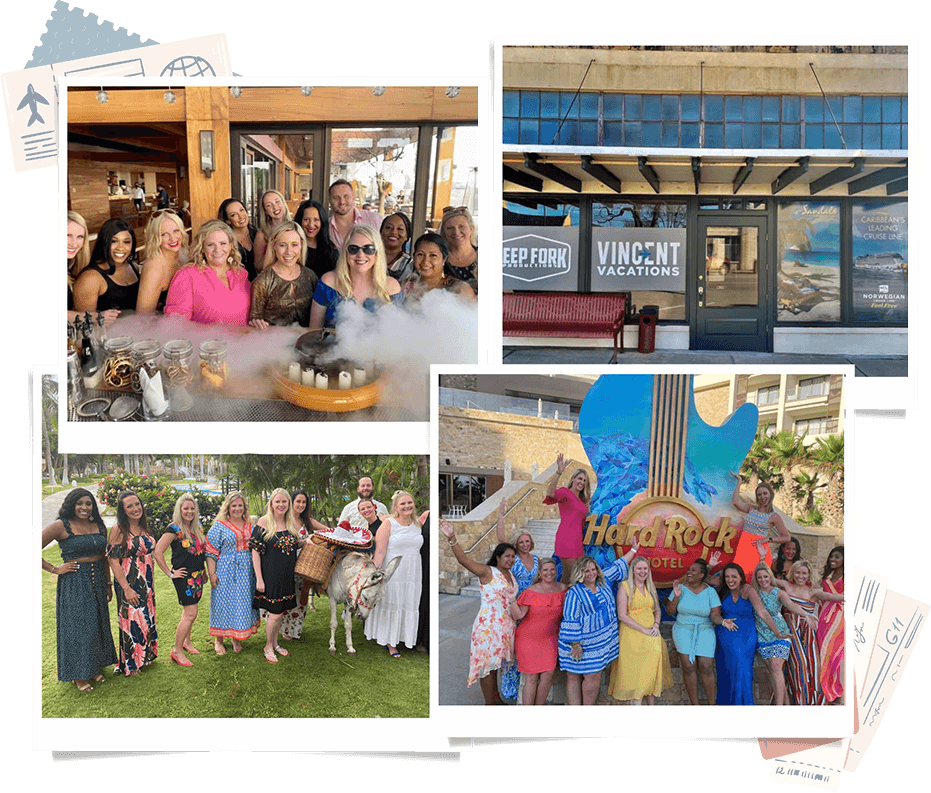We have the best deals and packages for Culinary Delights of Central Europe Travel Tips - . Our cruise travel agents book clients all over the USA. We are your ocean and river cruise experts. Interested in a custom package? Get a custom quote now.
We recognize that cruise vacations are not just an investment, but often the highlights of our lives, and we take that responsibility seriously. We want to ensure you have the best vacation experience. Interested in a job in travel? Click here to learn: How to Become a Cruise Travel Agent
| Culinary Delights of Central Europe | |
 In country after country, there are countless good restaurants reflecting the unrelenting high standards of the Europeans themselves. And while many of the best have Michelin stars and can be on the pricey side, one very easily dines well almost everywhere at decent prices. Of course it’s all a matter of taste, but you’re going to find Central Europe full of delicious discoveries. An army marches on its stomach,” Napoleon Bonaparte once declared. Updating that proclamation to modern times: between museum exhibits, castle hopping and souvenir shopping, travelers on the road through Central Europe have to eat, too. And they can look forward to wonderful soups, game, forest products such as mushrooms and wild berries, and truly extravagant pastries. In the six countries of heartland Europe, count on enjoying good food, fine wine and great beer. Every trip should encompass at least one extraordinary culinary experience, a meal that broadens your knowledge of indigenous ingredients, preparation and presentation. In country after country, there are countless good restaurants reflecting the unrelenting high standards of the Europeans themselves. And while many of the best have Michelin stars and can be on the pricey side, one very easily dines well almost everywhere at decent prices. Of course it’s all a matter of taste, but you’re going to find Central Europe full of delicious discoveries. Austria On Dining Austrians take their food seriously, and regional cuisine is varied, taking advantage of local produce and high quality farm products. Many restaurants and local inns offer outstanding regional delicacies rarely found elsewhere. Viennese cuisine also offers many serious classics enjoying world recognition: Wiener Schnitzel (veal scallops, breaded, deep-fried in fresh oil) is one of the most traditional dishes; Wiener Backhendl, the queen of fried chicken; Tafelspitz mit Kren (boiled beef fillet with horseradish); Frankfurter sausages, which contrary to popular belief, originated in Vienna not Germany. Austrian desserts, served with the ritual late-afternoon coffee or after dinner, are synonymous with Vienna: There is Apfelstrudel (applestrudel), jam-and-nut filled Palatschinken and torte, a layered cake with a wide choice of filling. The most famous, of course, is the Sachertorte, a chocolate cake filled with apricot jam and iced with chocolate. On Drinking There is something unique and yet paradoxical about Austrian wine culture. It is one of the oldest in Europe, yet one of the youngest to be recognized worldwide. Unique to Austria is the Gruener Veltliner grape, used in both light and full-bodied white wines, that accounts for more than a third of local wine production. Of Austria’s five major wine-growing regions, the Wachau encompasses the lush Danube Valley west of Vienna and is the most prominent. The city of Vienna itself is home to dozens of winemakers, and the city hills are dotted with vineyards. The casual visitor is most likely to encounter the Austrian wine experience in a local wine tavern called heuriger, which means both new wines and the taverns in which they are served. These are owned and operated by vintners, and they are wine places that may be in a large garden with long wooden tables for outdoor tastings, or inside wood-panelled stubens; food and often strolling musicians are part of the fare. The place to sample for good Austrian beer and meet people is a keller or a stube. Extraordinary Culinary Experiences (a sampling)
The Czech Republic On Dining Travelers can be assured that dining in Prague is not limited to meat and dumplings; yet when those specialties are good, they are wonderful. Czech and Moravian cuisine is available in top-quality restaurants as well as in taverns and beer halls. The national dish is roast pork or duck with cabbage and dumplings. And dumplings, called knedlik, are the very essence of Czech food: the Slavic answer to pasta, served also with roast goose, venison and hare. Of course Czechs still like their desserts - and so will you. Delicate crepes called palacinky, served with fruit or cheese fillings and whipped cream cottage cheese, and summery fruit dumplings with cottage cheese are favorites. Czechs are also carp crazy, the favorite way to serve up this “national fish” is with potato salad, traditional on Christmas Eve. While the traditionally hearty Czech fare still predominates outside Prague, salad bars have been added in many restaurants, and the big fast food is very good pizza. On Drinking In the Czech Republic, sample the famous beers - this is the home of a style of beer known as pilsner, which comes from the town of Pilzen; the town is also home to the major brewery, Pilsner Urqueel. There are more than 60 breweries in the Czech Republic, producing a golden brew that goes exceedingly well with the hearty national cuisine. But don’t neglect the wines, which since Roman times have been produced mostly in the beautiful wine-growing region of South Moravia, whose vineyards and cellars offer a warm welcome to travelers. The Czech wines are closer in character to Austrian wines rather German, and the white varietals especially can be excellent. Vintners nowadays are focused on quality, and wine lovers are responding, flocking to dozens of new wine bars and vinoteques found in every larger city. You’ll also want to try the country’s native drinks: Becherovka (a bittersweet herbal liqueur) and slivovice (plum brandy). Extraordinary Culinary Experiences (a sampling)
Germany On Dining The cuisine of Germany can be as refined, or as down-to-earth as any in the world. In recent times, there has been a national cholesterol consciousness-raising. But the sauerbraten, wursts, pumpernickel, dumplings and potato pancakes with applesauce and red cabbage are still alive, well and delicious. As are the Konditoreien, those irresistible pastry shops offering (among many other things) Black Forest cake - a bonanza of chocolate, cream and cherries---or many varieties of Apfeltasche (apple pastry), accompanied by Kaffee mit Schlag (cream). On Drinking Beer is Germany’s world-famous national drink, served at beer halls and taverns, particularly in the southern part of the country. Brewed across the nation, the beers vary from light (helles) to dark (dunkles). Munich is the capital of beer drinking and a visit would not be complete without taking in the Hofbräuhaus beer hall, and in summer, a beer garden. The city is particularly well- known for its Oktoberfest, the world’s largest beer festival, held late September and early October. Let’s not forget, however, that Germany gives us many superb wines. Thirteen different wine-growing regions, producing mostly white wine, stretch from Bonn south to Lake Constance, with each region’s wines having a very distinctive flavor. The wine regions often have a sign-posted route that combines sights and wine cellars, both at their best in the Moselle and Rhine valleys. You can sample wines by the glass in taverns (weinstubes), while restaurants offer house wines served in pottery jugs, as well as bottles from the wine list. The most appealing way to celebrate German wines is to attend one of the more than 500 wine festivals that take place from July to late October. Extraordinary Culinary Experiences (a sampling)
Hungary On Dining Traditional Magyar cuisine is considered spicy and substantial. Paprika and sour cream are essential to many national dishes including chicken paprikash with noodles (spetzles); stuffed cabbage, and goulash, which contrary to popular belief is not a stew but a hearty soup made of beef, onions, potatoes and other vegetables. Always leave room at the end of a meal for sweets and pastries, such as strudels made with sour cherries, apples or farmers cheese; the legendary walnut-filled Gundel pancakes; or somloi galuska, a whipped cream and chocolate-crowned sponge cake with nuts and raisins. On Drinking The most distinctive red wines come from Villany-Siklos, and the best white wines from the vineyards around Lake Balaton and in Somlo. The reds from Eger and sweet whites from Tokaj are much better known abroad, however, and these two regions are the most dynamic when it comes to wine production. Wines of the 22 regions are introduced in the House of Hungarian Wines, located in the Castle District of Buda, and several festivals are dedicated to the fruits of the vine: the Budapest International Wine Festival is held in September, while other Grape Harvest and Wine Song Festivals are held in other corners of the country. Extraordinary Culinary Experiences (a sampling)
Poland On Dining Setting an elegant table is an element of Polish hospitality; serving a hearty and lavish meal is a long-held tradition. Dishes include white or red borscht, tripe soup, pork chops, beef rollanti with buckwheat, and golabki (cabbage rolls). Such famous delicacies as boiled or deep-fried pierogis (stuffed dumplings) and kielbasa (smoked sausage) are available everywhere. The most national of dishes is bigos (sauerkraut and meat or Hunter’s stew”) and barszcz (Easter beetroot soup). On Drinking Poles are passionate tea drinkers, consuming their tea with each meal and then in between. Wine and beer are often imported in Poland, although Zywiec and Okocim are good local beers. Home grown, of course, is vodka, the country’s signature alcoholic brew and as much a national drink here as in Russia. Vodka is not a cocktail or mixed drink ingredient; it is served and swallowed neat. Further vodka comes from sweet to dry, as well as in various colors. One brand, Zubrowka Bison, is flavored with grass on which the bison feeds in the Bialowieza forest. There’s always a blade of grass in the bottle. Other popular spirits include Sliwowica, made from plums, and Krupnik honey liqueur, made from mead. Nazdrowie (to your health) is a useful word to learn. Extraordinary Culinary Experiences (a sampling)
Slovakia On Dining When in Slovakia, try some of the following specialities: bryndzove halusky (potato dumplings with melted sheep cheese sauce), ostiepok and parenica (traditional smoked and un-smoked Slovak cheeses, hus s loksami (goose meat and liver with potato pancakes). Then sample the pastries, tortes, ice cream and other desserts such as palacinky (crepes filled with plum jam) available at cafes, ice cream parlors and cukraren (sweet shops). Dining in the capital often means enjoying an Old Town wine cellar setting, even when the featured cuisine might be Austrian, Hungarian, Italian, French and Kosher cuisines. On Drinking As in the Czech Republic, national Slovakian wines can be very good. The Small Carpathian mountain region running north from Bratislava produces white wines such as Rhine Riesling, Chardonnay, Rulander and the famed Tramin cerveny. Sparkling wines are also on the local list, and half of the famous Tokaj wine region (shared with Hungary) lies in southern Slovakia. Tokaj wines are predominantly sweet white wines, similar to its Hungarian counterpart Tokay. Local beverages also include the sparkling non-alcoholic drink Vinea, made from white of red grapes; excellent pilsner-style beers; kofola, the equivalent of root beer served on tap. Extraordinary Culinary Experiences (a sampling)
| |
| BACK | |
Vincent Cruises - Authorized Culinary Delights of Central Europe Travel Tips - Vacation Planner
Questions? Call us at
1 (888) 883-0460
Contact us for the latest Culinary Delights of Central Europe Travel Tips - deals.
For Groups of 10
or more rooms, or 8 or more Cabins, please use of Group Form
Click Here for our Group Department
Click on a location below to learn more. We recognize that vacations are not just an investment, but often the highlights of our lives, and we take that responsibility seriously. We want to ensure you have the best experience.

All of these are signs that you are a great fit to become an independent travel agent, and turn your love of travel from passion into profit!
Learn MoreOur motto at Vincent Vacations is, we go so you know! We want to ensure you have the BEST experience, whether it's a river cruise, or a corporate group incentive trip, we want to ensure your vacation is a success.
We serve customers all across the USA
Debt free and in business since 2013. Vincent Vacations has agents in Dallas, Kansas City, Houston, Shreveport, Little Rock, Roswell, Oklahoma City and more locations.

Travel agents can help save time and stress by doing the research and handling all your bookings for you. An experience travel agent is best at finding great deals and packages, as well as providing you with helpful information and tips. They can also help you plan special activities and experiences that you may not have thought of on your own. All in all, using a travel agent can be a great way to make sure you get the most out of your trip.
In travel since 2002, and in business since 2013, our travel team serves clients all over the US. Planning a vacation away from home takes a great team. We have taken the time to build a team of dedicated, smart, hard-working personnel who are each committed to excellence and service. We work side-by-side, creating and ensuring INCREDIBLE vacation experiences for you and your group. Our store front in-office team, and our travel consultant independent contractors, work all around the US - we even have a travel agent who lives in Mexico!


In business since 2013, we are your #1 source for travel!
Free Cruise Package Quote